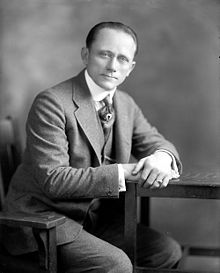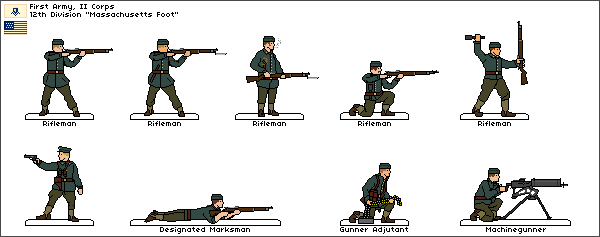
A picture of men from the 33rd Freedom Party Guard Division
Calvert resting on the beaches of Tidewater Virginia, ca. 1944.
The Confederacy was always doomed to have less manpower than the US, a problem further exacerbated by the US annexation of Canada and several key pieces of former Confederate territory in the wake of the First Great War. To help combat this the Confederacy would resort to a variety of ingenious solutions, most notably the introduction of assault rifles and submachine guns for their infantry and faster firing machine guns. Lesser known were the numerous Northern Legions. The history of the North units could be traced back to the multiple pincer movements conducted during Operation Blackbeard that yielded thousands of prisoners for the Confederacy. Rather than let all of this critical manpower go to waste, the Confederates began to implement a series of programs where prisoners could be let out of camps in exchange for working in Confederate factories and farms. It quickly became clear to Ferdinand Koenig the immense value that these men would have in clearing up much needed whites for military service, and soon tens of thousands of Northern POWs were forcibly brought out of the POW camps and into the munition plants, oil refineries, and farms of the South, under close watch, of course. By mid 1942 it was estimated that this effort had cleared up some 125, 000 Southern whites for military service, men desperately needed with the fighting in Ohio and western Pennsylvania costing far more casualties than expected.
For a while this system was sufficient for the Confederacy, but that would change in the aftermath of the Northern victory at Pittsburgh and the destruction of much of the Confederate Army of Kentucky, which suffered over 250, 000 casualties in the battle. This crippling blow tore a massive hole into Confederate lines that simply could not be filled, Southern manpower reserves already stretched to the breaking point fighting the war against the North, the black insurgents, and elsewhere. This would be the deciding factor for Koenig to suggest the idea of setting up mass collaborator units to fight for the South. Really it wasn't a totally new concept. Ever since 1941 Northerners had been fighting in the Southern armies, but these were mostly people who had escaped across the border in the opening weeks of the conflict to defect to the CSA. In this manner several CS units had been established from out of the Northern population pool, including two Missourian divisions, two West Virginian, a Maryland, and a Sequoyah division. Now Koenig looked to these units for inspiration for what would become the Northern Legions.
The Northern Legions would be raised from amongst the throngs of US POWs sitting idly by in camps across the South. Much like the industrial and agricultural work programs, these men would be "volunteered" for service in regular CS outfits manned by former US POWs and staffed by Southern (or, in some cases, Mexican) officers. The idea was immediately given the greenlight by Featherston, who saw the propaganda value having such units could have (they would be filmed by Saul Goldman as "evidence" of the common Northerners' support for the Freedomite struggle against "Marxist-Negr* Rule"). An initial order for 350, 000 such men was filed by the Confederate Army in March of 1943, with this being more than doubled to 800, 000 in June after the US landings in Kentucky.
The first units began to be assembled as early as the first week of April, and by the end of May some 75, 000 Northerners had been "volunteered" for service in CS Army outfits. Despite pleas from such figures as Patton for use on the front, these were all placed at secondary positions to clear up regular Confederate units for the front. By late summer of 1943 some 100, 000 Northerners were employed to man the South's numerous anti-air craft batteries alone, the commander of Richmond's defenses famously pointing out the irony that the AA guns had to be manned by Yankees as he requested another 5, 000 men for his guns in August of that year. Elsewhere the Northerners were also sent to replace Confederate garrisons at forts scattered across the Gulf and Atlantic coasts, most famously Fort Fisher at Wilmington and Fort Featherston (ironically enough) at the entrance to Charleston Harbor. But perhaps the most famous deployment of these "Galvanized Yankees" would be against the black guerrillas of the cotton belt. By early 1944 over 60% of all "Confederate" units operating against the guerrillas were actually Northern POWs. Despite initial worries on the part of skeptics in the Guards, these POWs developed a reputation for extreme ruthlessness against the blacks, many blaming the blacks for the South having seceded in the first place.
But that didn't mean that no Northerners were recruited into combat positions. Particularly ideologically sound individuals were often cleared for military service if they proved themselves at their previous posts fighting guerrillas or manning AA guns. Some even joined the Freedom Party Guards. This was how the 33rd FPG Division
Calvert would become established. Much like the regular Freedom Party Guard units, the Northern collaborator ones were grouped along regional lines.
Calvert was thus comprised of Marylanders, Washingtonians, and Delawareans who had volunteered for service in the combat wing of the Freedom Party Guards. A total of seven such units would be created from Northern troops, these being
Choctaw (comprised of pro-Confederate Native Americans from Sequoyah),
El Dorado (from the Rockies region, including a regiment of Utah Mormons),
Ozark (from Missouri),
Keokuk (from Missouri and Downstate Illinois),
Allegheny (from Ohio and Pennsylvania),
Kanawha (from West Virginia), and
Calvert. Aside from these, two other foreign Guards units would be created by 1944, these being
Montezuma (from the Empire of Mexico), and
Antilles (comprised of white British and French citizens from the Caribbean). These foreign units would go on to become some of the most feared units in the entire Guards outfit, infamous for their tenacity at such battles as Massanutten Mountain, Clemson, Huntsville, and leading the Confederate counterattack in the Wilderness during December 1943-January 1944. A total of 120, 000 men would serve in all foreign Freedom Party Guards outfits during the war, another roughly 500, 000 in the regular Northern Legions.
After the war many Northern generals were torn on how to treat their fellow countrymen who had served with the Confederate armed forces. Some figures argued that they be shot for treason, but in the end cooler heads prevailed and almost all of those "volunteered" for service (whether in factories, farms, or the armed forces) were cleared of any wrongdoing, the blame instead being passed on to the various Confederate officials who had okayed the initiatives in the first place. As for the various Freedom Party Guards divisions, however, the Northerners would not be so lucky. All survivors were arrested for treason, some 1, 000 being executed for it by the end of 1946. On top of this, all of the foreign Guards units were found complicit in several, outrageous crimes against humanity, including the murder in cold blood of over 150 black truck drivers at the hands of Freedom Party Guards Division
Ozark in Kentucky in June of 1943.








